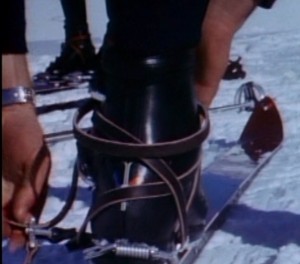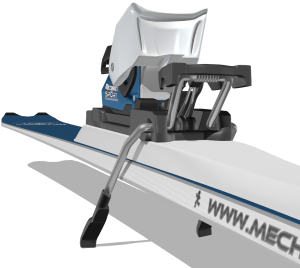 So who invented the first release ski binding?
So who invented the first release ski binding?
A Norwegian immigrant living in Oregon, Hjalmar Hvam, was recovering from a broken leg as the result of a skiing accident. It wasn’t his first! Frustrated, he decided to design a binding that would help prevent broken legs, by far the most common skiing injury. In 1939 Hvam introduced the Saf-Ski, the first release binding. He even had a catchy sales phrase “Hvoom with Hvam!” However his binding never gained widespread success.
I actually don’t want to write about release bindings. I want to write about the new problem they introduced: runaway skis! As Retro-Skiers we saw an evolution of solutions to that problem.
The long thong was a leather ski retention strap, a safety strap, that when the toe binding released kept you affixed to the heel unit and the ski. This could have been accomplished with a strap probably 18 inches long or even less, but why settle for 18 inches when 48 inches was available! Oh, there was another reason for this: the extra wraps of leather around the upper portion of a leather ski boot improved the forward support. However there were ramifications.

Long Thong used with Racing Heel (from Dick Barrymore’s “The Last of the Ski Bums”)
So just to remind you, here’s how to wrap a long thong. Take the long end (which should be on the inside edge of your ski) and wrap it around the boot front-to-back; then pass it through the ring on the opposite side of the binding; wrap the remaining strap back around the boot front-to-back; then pass it through the ring on the original inner side of the binding. How much strap do you have left? If it’s less than a foot, fasten it with the corresponding buckle on the outside of the binding. If it’s a foot or more, wrap it around the upper boot until there is less than a foot. That took care of one ski! Also it is probably worth noting that this had to be done bare-handed even on the coldest days.
Over time everyone developed their own unique wrapping approach which became a routine. If you wanted to screw up another skier, just cut 8 inches off one of their long thongs!
The first wrap of the day was the easiest since the leather straps were usually dry and pliable, but during a day of skiing the straps would become iced in spots so subsequent wraps were more difficult and colder on the hands.
Another special situation was Spring skiing! The warm temperatures and melting snow meant that the long thong straps became saturated with water. And what happens to leather when it gets wet? That’s right, it stretches! So now there were 2 more feet of long thong to wrap!
Now don’t you miss those days!
As plastic boots and releasable heel units began to proliferate, a shorter version of the long-thong, the Arlberg strap, was introduced. These still wrapped around the ski boot and then buckled. That meant you still had to bend over to put on or take off a ski so gondolas were not a popular lift choice!
The simplest safety strap was just a short leather strap hooked to the binding which you clipped to your boot laces. These had a tendency to break in violent falls producing the very thing they were supposed to prevent: a runaway ski. They also generated new injuries caused by wind milling skis striking the skier during a fall. I was a victim of a wind milling ski that cut my scalp open!
 In 1974 Klaus Obermeyer would introduce the first two-pronged ski brake to the United States. There had been earlier single pronged brakes available, but they never caught on for several reasons. You may recall earlier this season Klaus Obermeyer celebrated his 100th birthday!
In 1974 Klaus Obermeyer would introduce the first two-pronged ski brake to the United States. There had been earlier single pronged brakes available, but they never caught on for several reasons. You may recall earlier this season Klaus Obermeyer celebrated his 100th birthday!
Ski areas here in the United States were slow to accept ski brakes. There were concerns about the brakes’ effectiveness. There was the potential for a ski to come off while riding a lift and fall on someone below. Killington defined a policy, articulated by its marketing director Foster Chandler that you could use ski brakes at Killington, but you needed safety straps as well … huh? This policy was adopted by most U.S. ski areas.
By 1978 all the major binding companies were providing two-pronged ski brakes. Europe was allowing brakes on their slopes – without the additional safety straps. Eventually the U.S. areas would modify their policies as well.

March 27, 2020 at 10:59 pm
Hi have your book (enjoyed it a lot) and am enamored with all things skiing and old equipment. Over the last year I’ve been blending together my skills as a 3D solid modeling jock and my love of old ski bindings and made a bunch of videos around older ski bindings on era appropriate skis. Take a look…subscribe…maybe even like…
https://www.youtube.com/channel/UCv8DcrNXE1DDT9fkbtz3VEg?view_as=subscriber
That is HRG3Design if the link fails. I’m finishing up a Miller on a Toni Sailer ski with a Lange standard ski boot. Marker M4/TR on a Rossi is to be released next. Oh I’m looking for a Marker Telmat heel to model so I need to real thing…if you find one let me know please.